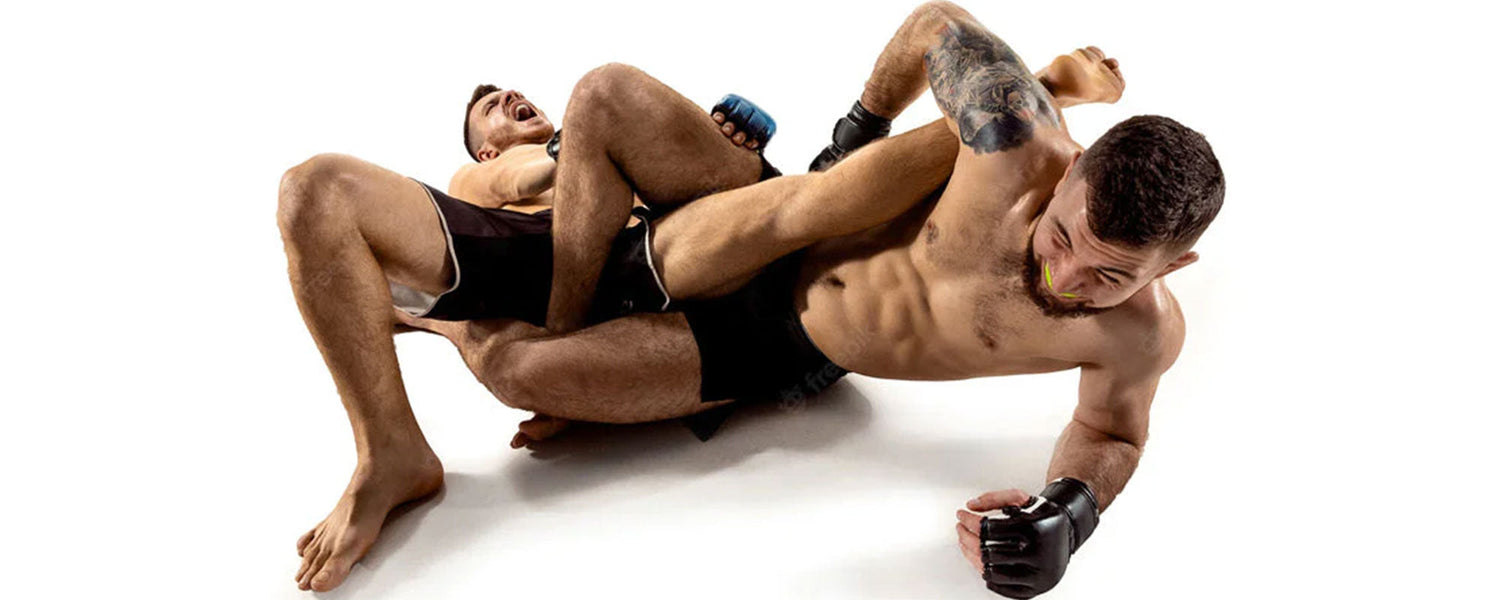Table of content
Brazilian Jiu-Jitsu (BJJ) continues to grow in popularity. New gyms are opening across the nation. Many UFC Championship athletes are involved in some kind of BJJ training. This begs the question of whether or not BJJ is a martial art that MMA competitors must have. This article will then examine the significance of BJJ in MMA.
BJJ is beneficial; however, it is not essential in MMA. It is among the top martial arts used for ground combat, but it does not prepare athletes for standing and clinching. Other combinations of martial arts include Sambo and wrestling, which teach ground fighting on top of standing and clinching.
Also read: Ultimate Guide to the Half Nelson in BJJ
1. What is BJJ?
Jiu-Jitsu, often known as Brazilian Jiu-Jitsu, is an advanced grappling martial art. The primary objective is to subdue your opponent with a lock or a choke. BJJ was initially created for self-defense, enabling individuals of smaller size to overcome a stronger and larger opponent by using leverage and techniques.
Traditional Japanese jiu-jitsu was brought to Brazil by the judo master Mitsuo Mezeda in the 1920s. Carlos Gracie and his successors would later transform this Japanese technique into what is known today as Brazilian Jiu-Jitsu.
BJJ retains elements of traditional martial arts like the belt ranking system. It is practiced in a uniform known as a gi, which is used in other Japanese martial arts like judo or karate. Today, BJJ can either be fought traditionally or in a sports setting.
While traditional BJJ is designed to be an aggressive sport, typically against an opponent who is not as well trained, the sports version is all about winning against skilled athletes in a grappling match.
BJJ is a fascinating sport. However, it's not ideal in self-defense or MMA where striking is permitted. Furthermore, BJJ can be practiced while wearing or without wearing a gi. Even though BJJ is highly specialized, there are different styles known as Gi and No-Gi BJJ which offer different techniques and expertise.
2. Is BJJ Still a Good Base For MMA?
When MMA began, it was a single martial arts style pitted against another. Nowadays, you are at a disadvantage if you enter the Octagon having only been trained in one specific discipline. This is true for all martial artists, not just those who specialize in BJJ.
Even though BJJ is utilized in MMA, you'll have to improve your skills by learning other forms of martial arts. However, BJJ still remains viable in MMA. Although fighters must be proficient in their technique, it doesn't mean they cannot concentrate more on more than one discipline at a time.
BJJ is an excellent martial art to start your MMA journey, especially if you're eager to study. Learning different styles of martial at the same time is a challenge, particularly if you've never practiced martial arts before.
Naturally, you can choose to attend an MMA academy to learn about techniques from teachers. However, it's better to become proficient in at least one martial art first before you move on to studying other styles. That way, you'll have a skillset at the same level as your competition.
Numerous MMA champions are excellent examples of this. Naturally, Nurmagomedov has training in striking martial arts, but his world-class wrestling style has allowed him to become the most dominant player in MMA.
You should not make BJJ your primary focus. Instead, you could train in grappling, Muay Thai, and other martial arts. However, you'll require a more comprehensive education for success in today's MMA world.
3. The Rising Popularity of Professional Wrestlers in MMA
Within the last decade, many UFC champions and top-level fighters with backgrounds in professional wrestling have taken part in MMA. Some notable examples are Colby Covington, Khabib Nurmagomedov, and Cain Velasquez. The way MMA fights are scored is not suitable for submission experts because you won't get a high score for subduing your opponent. However, you'll score a lot of points for knocking out your opponent.
Suppose a BJJ specialist cannot get his/her opponent to the floor and then subdue the opponent. What if Colby Covington took down a guardsman but was unable to get past an opponent's guard? He could take out the opponent, pull a reversal, and request that the referee get the wrestler up.
4. The Fall of BJJ in MMA
The decline of BJJ being practiced in MMA has been attributed to several reasons.
- The first thing to note is that everyone who is an experienced MMA fighter is well-versed in BJJ and has some understanding of the basics. If we examine the past 15 years, some fighters were skilled in sports like kickboxing but would get into an opponent's guard and not know what to do next.
- Examining events are a lot of competitors who don't know anything more than a few striking styles. Another instance is the beginning of MMA legend Bas Rutten's career. He lost three fights because they did not allow him to make full of grappling techniques. But he quickly learned from his mistake and never lost another fight via submission.
- The rules have changed significantly since the Vale Tudo Tournament. Before when there was no time limit, there were now time limits for each round. The initial round typically lasted around 15 minutes. In the modern-day UFC/Bellator fights, it takes about 3.5 minutes to take your opponent to the ground and 60 seconds to get on top of your opponent's back. If you were fighting in a 15-minute round, you would have 10.5 minutes to finish your opponent.
5. What Level of BJJ is Required to Be Used in MMA?
It is not necessary to be a BJJ belt holder to participate in MMA. The belt ranking system is challenging to assess in MMA because many fighters like Demetrius Johnson fought without a gi.
Though who do not wear a belt may possess the capabilities of a higher belt rank. However, they are technically considered a lower belt rank. For instance, Demetrius Johnson was considered a white belt throughout his career while being allowed to compete against black belts. He later received his brown belt after his training in Gi Jiu-Jitsu began.
While you don't need to have a specific belt to take part in MMA, most of the accomplished fighters who have completed their training in jiu-jitsu are, at a minimum, a purple belt.
6. Which Fighting Style is the Most Suitable for Mixed Martial Arts?
As mentioned before, if you want to succeed in the world of MMA, you want to make sure you have a good set of skills to reduce the likelihood of mistakes. Your striking game must be strong, as must your ground game and takedowns. However, BJJ is the easiest martial art to learn if you wish to compete in MMA. Naturally, fighters need to know how to grapple, too. Fighters need to know how to both strike and wrestle. However, a world-class wrestler will typically beat an elite striker if they are both experts. One excellent illustration of this is the bout between Conor McGregor and Khabib Nurmagomedov.
7. Study both No-Gi BJJ
What to do next? BJJ and wrestling are both grappling art forms, so what is next?
The best way to begin MMA is to study both No-Gi BJJ and wrestling. It's best to concentrate on one discipline initially, but No-Gi BJJ and wrestling tend to work well together.
A technique that BJJ lacks but wrestling has is the takedown. In contrast, wrestling does not include submissions BJJ does. When you're looking to get into MMA, the best option is to concentrate on grappling without a gi.
If you're young and attend a school that teaches wrestling, take the opportunity to learn as much as you can. If you can attend BJJ classes in the evening, you'll build an excellent grappling foundation in MMA. You can then gradually incorporate striking into your training.
Enrolling in a school that specializes in MMA is yet another alternative. One can argue that it's the best option available. But many top trainers believe that focusing on one martial art at a time is the best choice. If you are new to martial arts, master one martial first. If you have some experience, move on to MMA right away.
8. Should You Start MMA or BJJ?
This question, like all things in life, is up to the individual. Do you wish to be able to adapt or specialize in a single martial art? Are you looking to learn striking or not? When do you think you are ready to acquire new techniques? What is your current level of fitness?
Answering these questions can give you a better idea of whether to pick MMA or BJJ. Each martial art is excellent and committing your time and energy to both is a wise investment. Many people begin with MMA but then decide to commit to BJJ.
Some begin with grappling but find that it's not enough. Go to the gym, challenge yourself, and think about what you like most about working out.
9. Summary
While BJJ isn't useless or unusable, it is not compatible with MMA. Compared to other martial arts, you cannot use BJJ as efficiently. Although BJJ cannot always be used effectively in MMA, it's still a good martial art to learn.
Martial art styles evolve, and fighters get better over time. The overall level of BJJ displayed in MMA is very different from what it was a decade ago. There isn't a single boxer in the UFC that isn't familiar with the basics of ground play, and most fighters are well-versed in the fundamentals of BJJ.












Leave a comment
This site is protected by hCaptcha and the hCaptcha Privacy Policy and Terms of Service apply.